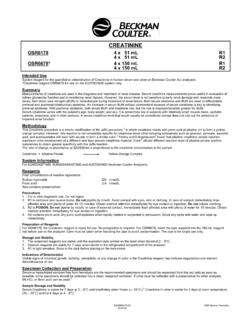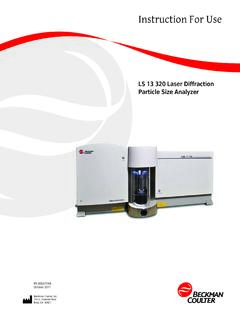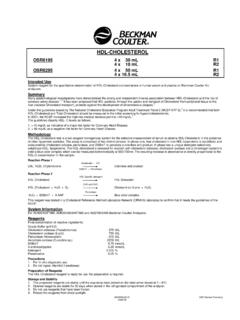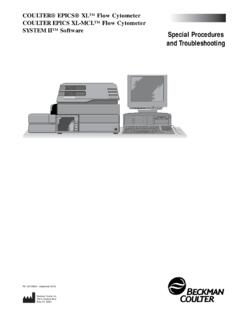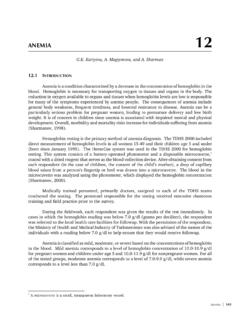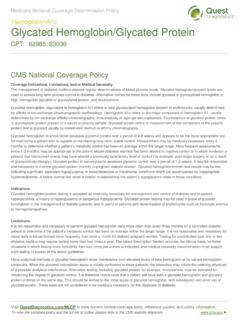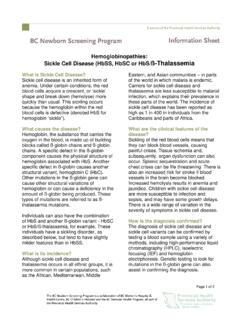Transcription of HbA1c (Hemoglobin A1c) - Beckman Coulter
1 OSR Special Chemistry 2009-08 HbA1c ( hemoglobin A1c) OSR6192 HbA1c 2 x 19 mL R1 2 x 19 mL R2 Total hemoglobin 2 x mL R1 Intended Use System reagents for the quantitative determination of HbA1c ( hemoglobin A1c), in human blood, on Beckman Coulter AU analyzers. The absolute HbA1c and Total hemoglobin (THb) values generated as part of the HbA1c assay are intended for use in the calculation of the HbA1c /Total hemoglobin ratio, and must not be used individually for diagnostic purposes.
2 Summary1 HbA1c is formed by the non-enzymatic glycation of free amino groups at the N-terminus of the -chain of hemoglobin A0. The level of HbA1c is proportional to the level of glucose in the blood. As the glucose remains bound to the red cell throughout its life cycle, measurement of HbA1c provides an indication of the mean daily blood glucose concentration over the preceding two months. Measurement of HbA1c is, therefore, considered to be an important diagnostic tool in the monitoring of dietary control and therapeutic regimes during the treatment of diabetes. Effective control of blood glucose levels is important in the prevention of ketosis and hyperglycemia, and may reduce the prevalence and severity of late diabetic complications such as retinopathy, neuropathy, nephropathy, and cardiac disease. Methodology The concentrations of both HbA1c and Total hemoglobin are determined. The HbA1c /Total hemoglobin ratio is expressed as percentage HbA1c (% HbA1c ).
3 The assay for percent HbA1c , involves the use of four reagents: Total hemoglobin reagent, HbA1c R1 antibody reagent, HbA1c R2 agglutinator reagent, and hemoglobin Denaturant (sold separately as Cat # OSR0004). In a pretreatment step, the whole blood is mixed with hemoglobin Denaturant (Cat # OSR0004) in a 1:41 dilution and incubated for a minimum of five minutes at room temperature. The red blood cells are lysed and the hemoglobin chain is hydrolyzed by the protease present in the reagent. Total hemoglobin is measured via the conversion of all hemoglobin derivatives into alkaline hematin in the alkaline solution of a non-ionic detergent. Addition of the pre-treated blood sample to the Total hemoglobin reagent results in a green solution, which is measured at 600nm. HbA1c is measured in a latex agglutination inhibition assay. An agglutinator, consisting of a synthetic polymer containing multiple copies of the immunoreactive portion of HbA1c , causes agglutination of latex coated with HbA1c specific mouse monoclonal antibodies.
4 In the absence of HbA1c in the sample, the antibody-coated microparticles in the HbA1c R1 and the agglutinator in the HbA1c R2 will agglutinate. Agglutination leads to an increase in the absorbance of the suspension. The presence of HbA1c in the sample results in a decrease in the rate of agglutination of the HbA1c R1 and the agglutinator in the HbA1 reagent R2. The increase in absorbance is, therefore, inversely proportional to the concentration of HbA1c in the sample. The increase in the absorbance is measured at 700nm. System Information For AU400/400e/480, AU600/640/640e/680, AU2700/5400 Beckman Coulter Analyzers. Reagents HbA1c R1 HbA1c R2 HbA1c Antibody (mouse) coupled particles HbA1c Hapten Bovine Serum Albumin Bovine Serum Albumin Buffer pH Buffer pH Surfactant: Non-ionic detergent Surfactant Preservative: Proclin Preservative: Proclin Total hemoglobin R1 Sodium hydroxide ; pH 13 Surfactant: Non-ionic detergent Precautions 1.
5 For in vitro diagnostic use. 2. Do not ingest. Harmful if swallowed. 3. Irritating to eyes and skin. 4. Exercise the normal precautions required for handling all laboratory reagents. 5. Dispose of all waste material in accordance with local guidelines. 6. Safety data sheet available for professional user on request. Preparation of Reagents Total hemoglobin R1 and HbA1c R2 are ready for use, and can be placed directly on board the instrument. No preparation is required. HbA1c R1 should be mixed by inversion 5 10 times before placing on board the instrument and at weekly intervals thereafter. Storage and stability2 1. The unopened reagents are stable, up to the stated expiry date when stored at 2 to 8 C. 2. Opened bottles of reagent are stable for 30 days when stored in the refrigerated compartment of the analyzer. Indicators of Deterioration Visible signs of microbial growth, gross turbidity, precipitate, or change in color in the HbA1c or Total hemoglobin reagents may indicate degradation and warrant discontinuation of use.
6 HbA1c ( hemoglobin A1c) OSR Special Chemistry 2009-08 Specimen Collection and Preparation2 K2-EDTA or NH4-heparinized whole blood. Before use, pre-treat samples and HbA1c Control (Cat # ODC0022) by adding 25 L of whole blood sample or reconstituted control, as appropriate, to 1000 L of hemoglobin Denaturant (Cat # OSR0004) [1:41 dilution]. Mix thoroughly, avoid foaming, and incubate for 5 minutes at room temperature before use. HbA1c Calibrators (Cat # ODR3032) do not require pre-treatment. Please note that only hemoglobin Denaturant (Cat # OSR0004) can be used with this method. Strictly follow the pre-treatment instructions for the use and handling of OSR0004 ( hemoglobin Denaturant). Sample Storage and Stability2 Samples (non-pretreated) are stable up to 1 week when stored at 25 C, 2 weeks when stored at 2 -8 C, and up to 6 months when frozen at -70 C. Denatured (pretreated) samples are stable up to 8 hours when stored at room temperature, up to 48 hours when stored at 2 to 8 C, if stored in a sealed container.
7 Interfering Substances Results of studies conducted to evaluate the susceptibility of the method to interference were as follows: The criteria for no significant interference is recovery within 10% of the initial value. Bilirubin: No significant interference up to 30 mg/dL Bilirubin Lipemia: No significant interference up to 500 mg/dL Intralipid * Triglyceride: No significant interference up to 1600 mg/dLTriglyceride *Intralipid is a 20% IV fat emulsion used to emulate extremely turbid samples, (manufactured by KabiVitrium Inc.). Rheumatoid factor (RF) up to 2000 IU/mL, acetylsalicylic acid (60 mg/dL), sodium cyanate (50 mg/dL) and urea (500 mg/dL), do not interfere with this assay. Refer to Young3 for further information on interfering substances. Procedure Total hemoglobin and HbA1c tests must be performed on each pre-treated sample and control. A complete list of test parameters and operational procedure can be found in the User s Guide appropriate to the analyzer.
8 Materials provided Total hemoglobin Reagent HbA1c Reagent Materials required but not provided HbA1c Calibrator (Cat # ODR3032) hemoglobin Denaturant (Cat # OSR0004) Stability of Final Reaction Mixture The Beckman Coulter AU analyzers automatically compute every determination at the same time interval. Calibration4,5,6 The frequency of calibration for the HbA1c procedure is every 14 days. Calibration of this HbA1c procedure is accomplished by use of the HbA1c Calibrator (Cat # ODR3032). For calibration procedure, please refer to HbA1c Calibrator (Cat # ODR3032) Instructions for Use. HbA1c Calibrator (Cat # ODR3032) is a 6 point calibrator. Calibrator 1 is used for calibration of the Total hemoglobin assay. Calibrators 1 to 6 are used for calibration of the HbA1c assay. Recalibration of the test is required when any of the following conditions exist: 1. Change in reagent bottle or significant shift in control values. 2. Preventative maintenance was performed on the analyzer.
9 3. A critical part was replaced. Following calibration, the resulting curve should be visually reviewed, on the Beckman Coulter AU analyzer, for acceptability using the software options. Routine, Calibration Monitor and Calibration Curve. Calibrator assigned values are traceable to the Diabetes Control and Complications Trial (DCCT) via the Master Equation developed by the National Glycohemoglobin Standardization Program (NGSP) and International Federation of Clinical Chemistry (IFCC). Calibrator HbA1c values have been assigned by immunoturbidimetry using HbA1c (Cat # OSR6192) and are traceable to the IFCC HbA1c reference method via IFCC reference material. Total hemoglobin values are assigned to the THb Calibrator are traceable to the IRMM hemoglobin Cyanide Standard (BCR 522). Any instrument or reagent modification may invalidate the assigned value. The relationship between results from the NGSP network (DCCT aligned) and the IFCC network has been evaluated, and a Master Equation has been developed for interconversion of results from IFCC to NGSP units.
10 Master Equation NGSP = ( x IFCC) + Definition of the relationship between the two networks links IFCC-traceable results to clinically meaningful HbA1c results from the DCCT and the United Kingdom Prospective Diabetes Study (UKPDS). The Master Equation also provides these DCCT results with traceability to a higher order reference method. Quality Control: Special Instructions During operation of the Beckman Coulter AU analyzer, at least two levels of control material such as HbA1c Control (Cat # ODC0022) should be tested a minimum of once a day. In addition, these controls should be tested after calibration, with each new bottle of reagent, and after specific troubleshooting steps described in the appropriate User s Guide. Quality control testing should be performed in accordance with regulatory requirements and each laboratory s standard procedure. HbA1c ( hemoglobin A1c) OSR Special Chemistry 2009-08 Additional pre-treatment/QC recommendations for manual method: 1.
